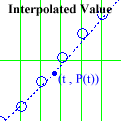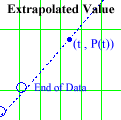Since the data values and the values generated by the equation follow the same general trend, we say that the equation fits the data.
Once we have an equation that fits the data, we can use the equation to generate all sorts of "predicted" data values that aren't part of the original data set. In particular, we can:
 Calculate values between known data values. This is called interpolation. It doesn't make much sense, in the stock price example, to use the equation to interpolate a daily closing price between two days. It might make sense, however, if someone had measured the rate of a chemical reaction at two different temperatures and we wanted to predict the reaction rate at an in-between temperature. Calculate values between known data values. This is called interpolation. It doesn't make much sense, in the stock price example, to use the equation to interpolate a daily closing price between two days. It might make sense, however, if someone had measured the rate of a chemical reaction at two different temperatures and we wanted to predict the reaction rate at an in-between temperature.
|
 Calculate values beyond known data values. This is called extrapolation. Once we have an equation that fits the data, we can extrapolate data values both before and after the interval on which the data was collected. For the example of the stock prices, we might extrapolate into the past to check our fitting function against historical data. If we are confident in the model, we might extrapolate into the future to predict tomorrow's closing price. Calculate values beyond known data values. This is called extrapolation. Once we have an equation that fits the data, we can extrapolate data values both before and after the interval on which the data was collected. For the example of the stock prices, we might extrapolate into the past to check our fitting function against historical data. If we are confident in the model, we might extrapolate into the future to predict tomorrow's closing price.
|
 Calculate values between known data values. This is called interpolation. It doesn't make much sense, in the stock price example, to use the equation to interpolate a daily closing price between two days. It might make sense, however, if someone had measured the rate of a chemical reaction at two different temperatures and we wanted to predict the reaction rate at an in-between temperature.
Calculate values between known data values. This is called interpolation. It doesn't make much sense, in the stock price example, to use the equation to interpolate a daily closing price between two days. It might make sense, however, if someone had measured the rate of a chemical reaction at two different temperatures and we wanted to predict the reaction rate at an in-between temperature. Calculate values beyond known data values. This is called extrapolation. Once we have an equation that fits the data, we can extrapolate data values both before and after the interval on which the data was collected. For the example of the stock prices, we might extrapolate into the past to check our fitting function against historical data. If we are confident in the model, we might extrapolate into the future to predict tomorrow's closing price.
Calculate values beyond known data values. This is called extrapolation. Once we have an equation that fits the data, we can extrapolate data values both before and after the interval on which the data was collected. For the example of the stock prices, we might extrapolate into the past to check our fitting function against historical data. If we are confident in the model, we might extrapolate into the future to predict tomorrow's closing price.